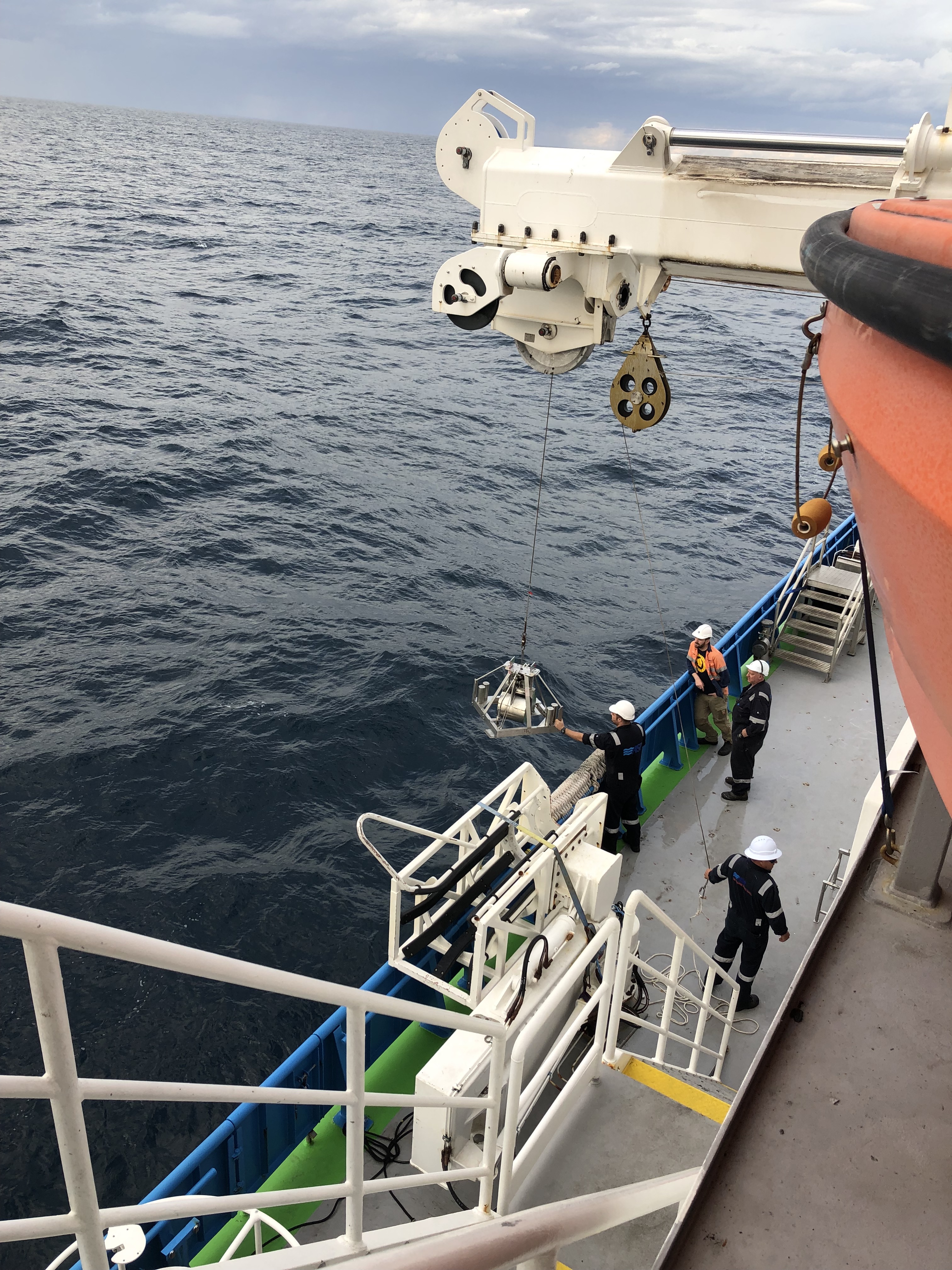By Jessie Bolin (2019 student alumni)
I’m Jessie, a first year PhD student at USC, and I was lucky enough to be a student participant on this year’s CAPSTAN voyage aboard RV Investigator from Hobart to Fremantle. The focus of the program was to train Australia’s next generation of interdisciplinary marine scientists, and we were exposed to field and lab techniques in sedimentology, geophysics, plankton, hydrochemistry, physical oceanography, and fauna identification. This was my first introduction to life at sea aboard a scientific research vessel, and I was hooked.

I have just returned from my second voyage on RV Investigator, where we spent 28 days cruising around the Coral Sea. The primary voyage goal, led by Chief Scientist Associate Professor Jo Whittaker, was to further understand the spatiotemporal extent of mantle plume activity in the Coral Sea, and to investigate how features in the region formed, like the Tasmantid and Lorde Howe seamount chains, and the Louisiade Plateau. This was done by using dredges (think of a massive net with teeth) to gather rock samples from seamounts and ridges, and using the multibeam echosounders to map the seafloor.

In addition to the primary project, the voyage had other supplementary projects:
- Understanding spatial links between geomorphology and biodiversity in the Coral Sea Australian Marine Park
- Spatial and temporal variability in the distribution and abundance of seabirds
- Collection of dead invertebrates dredged with geological samples
- Transit over the likely wreck sites of the USS Lexington and USS Neosho
- Educator on Board program

I was involved with the “Seabirds at Sea” project, and my role was a seabird and marine mammal observer for Birdlife Australia. A typical day for our team would involve starting observations at Monkey Island (the top level of the ship) just before sunrise, and recording the number, species, and behaviour of any observed seabirds and marine mammals through to sunset, using a standard survey protocol used since the 1980s. At the end of our journey through the Australian, Papuan, Solomon and New Caledonian EEZ’s, we recorded over 14,000 seabirds and 27 species.

Out of the 27 species, my favourite was the red-footed booby. They’re quite the comical bird, and at one point, we had over 50 red-footed boobies perched on the mast (…and scientific equipment), which broke a record for RV Investigator. Boobies feast on flying fish, and it was beyond exciting watching the boobies chase and catch flying fish that were disturbed by the ship. Flying fish can glide up to 70 km/hr to escape predators, which makes the boobies even more remarkable! Also, I witnessed my first instance of kleptoparasitism by a frigatebird. Instead of catching their own food, frigatebirds incessantly harass other birds – usually boobies – causing the victim to regurgitate their own food, which the frigatebird then steals in mid-air.

The Investigator is a ship for all scientists, which meant I was exposed to a diversity of perspectives and scientific research from completely different research areas to my own. Each day we’d have a ‘science talk’, where someone volunteered to give a talk about something they’re working on. Talks were diverse, and ranged from intraplate volcanism in Eastern Australia (Ben Mather, USyd), to using AUVs and ROVs to measure the spatial variability of algae under Antarctic sea ice (Vanessa Lucieer, UTAS), to methods of Ancient Egyptian mummy preservation (Quinn Anderson, USyd). Never in my life would I have thought I’d get to learn about Ancient Egyptian mythology on a research ship in the middle of the Coral Sea, yet there I was. We also celebrated international pet rock day, which was a real hit – particularly for the geology team!

A special moment for me (and many of the other scientists) was our final evening on the ship. The sun was setting, and we had just crossed into the East Australian Current on our way home to Brisbane. Seemingly out of nowhere, multiple pods of 50+ pilot whales and common dolphins appeared, and some of the dolphins started riding the bow waves! I’ll never forget the screams of excitement and complete joy that the marine mammals’ presence brought to the scientists and crew. They stayed with the ship for what felt like ages – it was a perfect end to a truly wonderful voyage.

For any budding marine scientist, I’d highly recommend going on RV Investigator. My background is in marine ecology and data science, yet going on this voyage meant I got to learn about marine geology and geophysics, and I even discovered a newfound interest for all things basalt and deep-sea volcanism. Being at sea for a month has taught me loads about the value of interdisciplinary marine science and working in a small, tight-knit community, and the experience has forged friendships for life. Thank you to the CSIRO Marine National Facility for a generous grant of sea time that made this voyage possible – I can’t wait to go back!










































 Last day group photo on the bow. Photo Credit: Marine National Facility/CSIRO
Last day group photo on the bow. Photo Credit: Marine National Facility/CSIRO Drone in flight at sea. Photo Credit: J Kaempf
Drone in flight at sea. Photo Credit: J Kaempf A seal was snoozing peacefully until we came along!
A seal was snoozing peacefully until we came along!  Students sort the rock dredge. Photo Credit: Marine National Facility
Students sort the rock dredge. Photo Credit: Marine National Facility Dolphins riding the bow wave
Dolphins riding the bow wave
